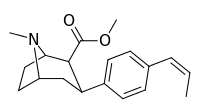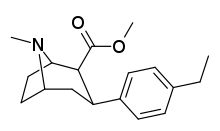RTI-83
RTI-83 ((–)-2β-carbomethoxy-3β-(4-ethylphenyl)tropane) is a phenyltropane derivative which represents a rare example of an SDRI or serotonin-dopamine reuptake inhibitor, a drug which inhibits the reuptake of the neurotransmitters serotonin and dopamine, while having little or no effect on the reuptake of the related neurotransmitter noradrenaline. With a binding affinity (Ki) of 55 nM at DAT and 28.4 nM at SERT but only 4030 nM at NET, RTI-83 has reasonable selectivity for DAT/SERT over NET

 | |
| Clinical data | |
|---|---|
| Other names | RTI-4229-83 |
| Identifiers | |
IUPAC name
| |
| CAS Number | |
| PubChem CID | |
| ChemSpider | |
| UNII | |
| ChEMBL | |
| Chemical and physical data | |
| Formula | C18H25NO2 |
| Molar mass | 287.403 g·mol−1 |
| 3D model (JSmol) | |
SMILES
| |
InChI
| |
However, further research has shown that by extending the ethyl chain even better selectivity can be achieved, with the 4′-(cis-propenyl) analogue having Ki values of 15 nM at DAT and 7.1 nM at SERT, vs 2800 nM at NET.[1][2] However RTI-436 has an even better selectivity for DAT over NET (3.09nM @ DAT & 1,960nM @ NET or a NET/DAT ratio of 634.3, but with lesser DAT/SERT equivalent potency with a ratio between them of 108) and RTI-88 has a still better ratio (984 NET/DAT with additionally having less selectivity than the former compound between DAT/SERT and having a more even spread of potency with the ratio between DAT & SERT being 88)
| Compound | DAT
[3H]WIN 35428 |
5-HTT
[3H]Paroxetine |
NET
[3H]Nisoxetine |
Selectivity
5-HTT/DAT |
Selectivity
NET/DAT | |||
|---|---|---|---|---|---|---|---|---|
| RTI-83 | 55 ± 2.1 | 28.4 ± 3.8 | 4,030 ± 381 | 0.5 | 73.3 | |||
| RTI-102 | 474 | 1928 | 43,400 | 4.06 | 91.5 | |||
| RTI-304 | 15 ± 1.2 | 7.1 ± 0.71 | 2,800 ± 300 | 0.5 | 186.6 | |||
| RTI-88 | 1.35 ± 0.11 | 120 ± 4 | 1,329 ± 124 | 88.9 | 984.0 | |||
| 83a* ‡ | 1.20 ± 0.29 | 48.7 ± 8.4 | 10,000.0 | 40.6 | 8,333.3 | |||
| RTI-143 | 4.06 ± 0.22 | 404 ± 56 | 40,270 ± 180 | 99.5 | 9,919.0 | |||
| *C3β-Ph-para=iodo, C2β-R=CO2-i-Pr, N8=CH2CH2CH2F ‡Compound code for phenyltropane in accord with Singh's "Chemistry, Design & SAR of cocaine antagonists" paper nomenclature, of no relation to RTI naming convention despite similarity to namesake of drug on topic.[3] | ||||||||
Such drugs are speculated to be useful as potential antidepressants, but few examples have been reported in the literature as yet. However, while RTI-83 has been used for binding studies to model the monoamine transporter proteins,[4] its pharmacology in vivo has not been studied in detail.
See also
- 4-Ethylamphetamine
- 4-Ethylmethcathinone
- UWA-101
References
- Blough, B. E.; Abraham, P.; Lewin, A. H.; Kuhar, M. J.; Boja, J. W.; Carroll, F. I. (1996). "Synthesis and transporter binding properties of 3 beta-(4'-alkyl-, 4'-alkenyl-, and 4'-alkynylphenyl)nortropane-2 beta-carboxylic acid methyl esters: Serotonin transporter selective analogs". Journal of Medicinal Chemistry. 39 (20): 4027–35. doi:10.1021/jm960409s. PMID 8831768.
- Singh S (March 2000). "Chemistry, design, and structure-activity relationship of cocaine antagonists". Chemical Reviews. 100 (3): 925–1024. doi:10.1021/cr9700538. PMID 11749256.
- Singh, Satendra (2010). "Chem Inform Abstract: Chemistry, Design, and Structure-Activity Relationship of Cocaine Antagonists". ChemInform. 31 (20): no. doi:10.1002/chin.200020238.
- Roman, D. L.; Saldaña, S. N.; Nichols, D. E.; Carroll, F. I.; Barker, E. L. (2004). "Distinct molecular recognition of psychostimulants by human and Drosophila serotonin transporters". The Journal of Pharmacology and Experimental Therapeutics. 308 (2): 679–87. doi:10.1124/jpet.103.057836. PMID 14593087.
External links
- Jin, C.; Navarro, H. A.; Carroll, F. I. (2008). "Development of 3-Phenyltropane Analogs with High Affinity for the Dopamine and Serotonin Transporters and Low Affinity for the Norepinephrine Transporter". Journal of Medicinal Chemistry. 51 (24): 8048–8056. doi:10.1021/jm801162z. PMC 2841478. PMID 19053748.